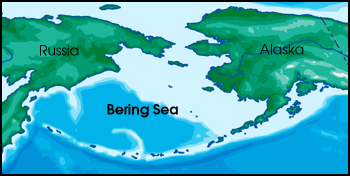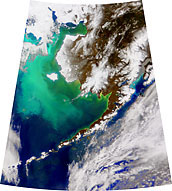


|
by John Weier |
||
|
During the past two summers (1997-98), a type of one-celled microscopic plant changed the color of the Bering Sea from its natural deep blue to a shimmering aquamarine in a matter of weeks. These plants, known as coccolithophores, produce and then shed hubcap-shaped, limestone (calcite) scales called coccoliths. Like all phytoplankton, the coccolithophores contain chlorophyll, are unicellular and have the tendency to multiply rapidly near the surface of the ocean. Yet, in large numbers, coccolithophores dump tiny white calcite plates by the bucketful into the surrounding waters and completely change its hue. |

Scanning Electron Microscope picture ofEmiliania huxleyi - a widespread species of coccolithophore. Each plate ("hubcap") is a separate coccolith, which will remain in the ocean after the organism itself has died. (Micrograph courtesy Jeremy R. Young, The Natural History Museum, London) |
||
|
The Bering Sea coccolithophores present a unique problem for researchers because a massive bloom of the organisms has never before been observed there. Many believe their arrival in the Bering Sea is yet another sign of a larger transformation in the surrounding ecosystem. The bloom's presence coincides with lower salmon counts along the coasts, a redistribution of microscopic animals in the surrounding ocean, and the massive deaths of shearwaters–hook billed, surface-feeding seabirds related to the albatross. Together, these events may spell major trouble for the Bering Sea ecosystem and the fisheries that ply these waters. An Eerie Calm off the Coast of AlaskaThe coccolithophore blooms formed primarily above the continental shelf to the west of Alaska. This underwater shelf is roughly the size of California and extends several hundred miles off the Alaskan coast, where it drops off to the floor of the Pacific. At their peak, the scaly plants covered practically the entire area. The only place where coccolithophores didn’t appear was in a 50-mile-wide band off the coast of Alaska. |
|||
 The size of this bloom over the last two years took many scientists by surprise. William Balch, a marine biologist at Bigelow Laboratory in Maine, has spent most of his career studying coccolithophores and their effect on the environment. He said, "The Bering Sea blooms happened at the wrong place at the wrong time." Given the stormy history of the Bering Sea, the coccolithophores should not be so abundant. Balch explained that most one-celled marine plants (phytoplankton) do not do well in still, lukewarm water. Marine plant "fertilizers," usually in the form of nitrates, come from deep, cold layers of the ocean and are brought to the surface by strong currents and inclement weather. When the water is calm and warm, the plants do not get these nutrients, so they cannot grow, Balch said. The coccolithophores are the exception. "They favor temperate conditions where the nutrients have been stripped away," said Balch. Under normal conditions, the coccolithophores do not compete well with other microscopic plants in nutrient-rich seas. When the competition is diminished by a low food source, the scaly plants have a chance. They usually end up proliferating in areas where the temperature is moderate, the sun is usually out, the water is calm, and the nutrient levels are low. The problem is that the waters in the Bering Sea do not fit this description. For years they were unsettled and turbid. Diatoms, another single-celled plant that produces a glass (silicate) outer covering, were known to dominate the upper layers of the region. Currents and storms brought plenty of nutrients from the deep waters in the Bering Sea onto the shelf. |
The coccolithophore bloom appeared over the continental shelf in the Bering Sea, represented in this map by the light blue off the west coast of Alaska. |
||
Yet over the past two years the coccolithophores have done exceedingly well, and the diatom population has dropped. The concentration of the coccoliths detached from coccolithophores reached nearly 6 million per milliliter over the past two summers. Balch said, "There is some evidence from sediments that coccolithophores have existed in the Bering Sea in the past for brief periods. But recent blooms are unprecedented." According to a National Atmospheric and Oceanic Administration (NOAA) report of the Fisheries-Oceanography Coordinated Investigations (FOCI) International Workshop on Recent Conditions in the Bering Sea (Stabeno et al. 1998), the environmental conditions there have changed over the last two years. Over the summer months, researchers found fewer nutrients than normal in the upper layers of the Bering Sea and warmer temperatures on the surface of the water. The report also pointed out a slew of other anomalies in addition to the coccoliths that occurred over the past two years in the Bering Sea. Most notably, the shearwaters began dying, an abnormally low number of salmon returned to the rivers emptying into the Bering Sea, and the distribution of microscopic animals (zooplankton) changed along the coastal waters (NOAA 1998). Common sense suggests that the armor-coated plants must be wreaking havoc on the animal life there. But most researchers have come to the conclusion that the presence of the coccolithophores is just another manifestation of a larger phenomenon. The coccoliths’ impact on the animal life in and around Alaska is actually thought to be of secondary importance.
The data used in this study are available in one or more of NASA's Earth Science Data Centers. |

Alaska and the Bering Sea from SeaWiFS on April 25, 1998. The bright aquamarine water is caused by the huge numbers of coccolithophores. This bloom was present in 1997 and 1998, and appears to be re-occuring in 1999. (Image courtesy Norman Kuring, SeaWiFS Project) |
||